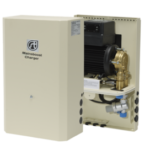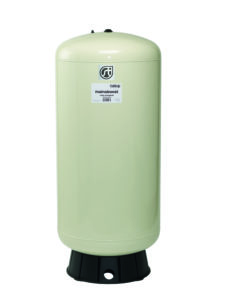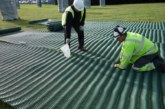For new build properties, it is vital that water pressure and flow rates be carefully considered, to make sure outlets throughout the house can be sufficiently supplied. Here, Darren Cooper, Business Development Director at Stuart Turner explains some of the most common causes of low water pressure and flow and how they can be rectified.
UK Regulations state that homes should be provided with at least 0.7bar of water pressure. However, as the pressure level is measured at the communication pipe serving the premises, the actual, delivered water pressure can vary throughout the home. For example, outlets on the ground floor could be supplied with one bar of water pressure, but those on the first and second floors could have much less. This can result in water trickling on higher levels of the property, which can be incredibly frustrating for the homeowner. Low water pressure and flow rates can also lead to low output when multiple sources are used at the same time – another potential problem for new occupants.
When water pressure and flow rates are insufficient, it is key that developers consider methods of boosting water pressure and flow. This will ensure that levels can be maintained throughout the property and allow the homeowner to use multiple outlets at the same time, without water pressure dropping.
Common causes of low water pressure and flow rates
Low water pressure and flow rates can be the result of a range of factors. One of the most common is the location of the property. Homes at the end of a pipe run can receive less pressure compared to those nearer the water supply. Properties situated on higher ground can also receive lower pressure – for example, homes at the top of a hill might have less than those at the bottom.
Pressure can also differ based on whom is supplying it. This means that, although 0.7bar is the required minimum, some areas can be supplied with more. Pressure levels should therefore be taken into account, to make sure that a new build property is supplied sufficiently – if not, a solution should be put in place.
How to rectify low water pressure and flow
If a property with an unvented system (where a property is supplied directly by the mains, rather than a break tank in the loft) is suffering from low water pressure and flow, it is recommended that a vessel be installed.
Vessels – such as Stuart Turner’s Mainsboost – contain a sealed water chamber, separated from the air space by a diaphragm. The chamber is surrounded by a positive pre-charged air pressure, which is sealed within the vessel. When the diaphragm is full (the water is supplied under the mains pressure), it expands to create a state of equilibrium between the water pressure and pre-charged pressure. When an outlet is opened, the water is forced out of the cylinder, boosting the incoming mains supply. Once the outlets are shut off, the diaphragm will refill and pressure equilibrium will be re-set.
Installing a vessel of this kind creates improved flow to the opened outlets and enables multiple sources to be used at the same time without the pressure dropping. This is a major benefit to the homeowner, as it means that they can make use of the home’s multiple outlets without water trickling. Vessels such as Stuart Turner’s Mainsboost are also a quiet solution – another advantage to occupants that should be considered.
In order for the Mainsboost system to work, it is vital that the incoming mains supply provides enough pressure to fill the vessel. If this is not the case, a charger pump can also be installed – this will ensure that water is fed into the vessel with enough force to pressurize it.
As well as improving flow rates, as the Mainsboost system is fully WRAS approved, the home can be supplied with drinking water throughout. This is not the case with vented systems, as quite often break tanks have removable lids with the potential to allow contamination in.
As maximising space is often a key factor for new build developments – the location of the vessel should therefore be considered. For example, depending on the layout of the pipework, vessels can be installed in the garage or in set cupboard space. Planning for the installation of a Mainsboost system in the pre-construction stages can therefore assist with maximising space within a property.
For new build developments, it is key that pressure and flow rates be considered to ensure that, if pressure and flow rates are insufficient, a solution can be put in place before it becomes an issue for the new residents. Stuart Turner’s Mainsboost is an effective way of supplying water under pressure and ensures that the homeowner can make full use of outlets without water trickling.




